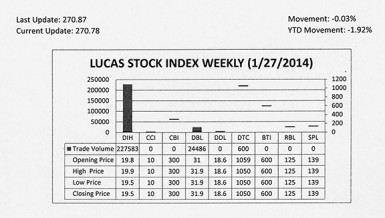Introduction
On January 28 last, a meeting was held in Linden that could be considered the continuation of a process that started last year to rebuild the region’s economy. It was a fascinating meeting that was hosted by the region and that saw parts of the local business community, investors seeking to participate in some form in the region’s agricultural prospects and technical experts from various disciplines in agriculture. The sincerity and enthusiasm of the participants were unmistakable. Emerging from that meeting was a clear consensus that the region had the potential to become a leading economic development centre of Guyana and the wider Caribbean region. The enthusiasm was sufficiently infectious that participants, young and old, wanted to know how they could get involved. It was reassuring therefore to hear that the region had committed itself to start follow-up work one week after the event. Participation in that meeting provides this writer with the opportunity to articulate some of the thinking that lay behind the hosting of the meeting and the rationale behind the economic thrust and outlook of Region 10.
Vision of Region 10
To understand what is happening in Region 10 requires understanding the forward-looking vision that it has of itself. The leaders of Region 10 see it as becoming the leading economic development centre of Guyana, the wider Caribbean and beyond. This vision which is still to be articulated publicly seeks to establish in the region integrated hi-tech education, research, production, processing, distribution, entertainment, cultural and financial entities to serve the people in and out of this region. The thrust of this thinking is one that would see Region 10 establishing strong and efficiently-run enterprises that employ well qualified personnel and utilize efficient business intelligence and effective decision support systems. There is a firm belief among the leaders that this vision is not only laudable, but achievable as well.
The most obvious and often overlooked reason for thinking of Region 10 in this manner is its geographic placement. Region 10 borders six of the remaining nine regions of Guyana. It could therefore serve as a source of food supply for more than half of the country. When the national population is taken into account, Region 10 is strategically placed to assist in meeting the food security needs of 80 per cent of the people of this country. With access to the Demerara River, Region 10 could also be a source of food supply to the Caribbean Single Market and Economy, North America and the rest of the world. In addition, Region 10 represents the current overland gateway to the largest economy in Latin America and the Caribbean and the eighth largest economy in the world. Through this route, it also offers access to the vast markets of South America. The immediate purpose of pursuing that vision is to improve the economic circumstances of the people not only of Region 10, but of the country as a whole. The sobering reality of all of this is that the region must first start by confronting the perilous economic situation that it faces.
Situation analysis
 The economic challenge starts with the misconception that the people of Region 10 are well off. The Census of 2002 identified Region 10 as being the most affluent in the country. Even as the country awaits the new census report, it is hard to understand how one could still hold that view more than 10 years later knowing the high levels of unemployment that exist in this area. To persist with such a view is to ignore the reality that the current infrastructure of the region is in a dilapidated state and is worsening. They cannot support robust economic investment as a result and this therefore leaves farmers and entrepreneurs in this region in an uncompetitive position. A World Bank funded study of 2007 on poverty in Latin America and the Caribbean undertaken by Gladys Lopez Acevedo and Emmanuel Skoufias and others observed that areas with poor infrastructure and inadequate access to public goods and resources were condemned to poverty. The infrastructure in Region 10 has been neglected and from budget allocations to the region, it appears as if the national priorities do not respect Region 10 as being of strategic value to the broader national interests of the country.
The economic challenge starts with the misconception that the people of Region 10 are well off. The Census of 2002 identified Region 10 as being the most affluent in the country. Even as the country awaits the new census report, it is hard to understand how one could still hold that view more than 10 years later knowing the high levels of unemployment that exist in this area. To persist with such a view is to ignore the reality that the current infrastructure of the region is in a dilapidated state and is worsening. They cannot support robust economic investment as a result and this therefore leaves farmers and entrepreneurs in this region in an uncompetitive position. A World Bank funded study of 2007 on poverty in Latin America and the Caribbean undertaken by Gladys Lopez Acevedo and Emmanuel Skoufias and others observed that areas with poor infrastructure and inadequate access to public goods and resources were condemned to poverty. The infrastructure in Region 10 has been neglected and from budget allocations to the region, it appears as if the national priorities do not respect Region 10 as being of strategic value to the broader national interests of the country.
A second important observation is that Region 10 is one of two regions in the country where the majority of households are headed by women. And even though their participation in the workforce has increased, the size of the female labour force participation remains lower than that of men. As is known also, the jobs available to women at the national level are not high-paying jobs. The situation of women in Region 10 is no different. Unknown to many is that non-communicable diseases are the most frequent cause of death among the people of Region 10.
Looking forward
Be that as it may, Region 10 holds significant advantage for Guyana and the pursuit of its vision could assure that this country does well in the future. This area of the country is known for bauxite, kaolin, laterite and other minerals and materials of construction value. Despite the abundance of the mineral bauxite, the cost of production is high. The bauxite is exported and the reliance on foreign markets exposes it to competition from cheaper sources. Dependence on that mineral alone always carries the risk that production could decline when market prices fall below acceptable levels. Bauxite mining cannot and should not be the only thing on which Region 10 depends, especially since it also contains other resources of economic value that are underutilized. The region therefore sees economic opportunity in non-traditional areas, particularly those of agriculture, eco-tourism and technology.
Potential of agriculture
This region has vast potential for both crop and livestock production and the opportunity for successful participation in this industry exists. One source that provides the evidence of that opportunity for successful participation is the table with the output index that appears in the annual reports of the Bank of Guyana. The Bank of Guyana gets its information from the Ministry of Agriculture and the Bureau of Statistics. The annual report of the BOG that is currently available is that of 2012.
Supply of crops
In that report, it is revealed that within a 12-year period, the level of production of 15 of the 16 crops reported on has fallen between 14 and 92 per cent. In nine of the 15 reported items, the decline was over 50 per cent. It is only in one instance, that of rice, that output has consistently increased over the review period. Otherwise, by way of example, cassava production is down 92 per cent; coconut production is down 81 per cent; plantain production is down 80 per cent; citrus is down 70 per cent; banana production is down 67 per cent; mango production is down 62 per cent; coffee is down 56 per cent; pineapple production is down 22 perent; eschallot production is down 14 per cent.
Supply of livestock
The national agricultural supply is not only dire in crop production. It is equally dire in livestock production. According to the National Development Strategy, Guyana had an estimated cattle population of 270,000 head of cattle in 1996. The National Dairy Development Programme reported cattle levels at 238,000 head at around 2010-11. This figure is equivalent to each person having access to one third of a cow for an entire year. What these statistics say is that current cattle supply is insufficient to meet domestic demand, let alone external demand. The situation is no different for sheep and goat production which population were reported to be of 300,000 and 150,000 head respectively. Poultry production remains popular and is the only livestock that has registered consistent growth over the period 2000 to 2012.
Validation
The opportunities for agricultural investment are validated by GO-Invest. In speaking of the comparative advantage that Guyana has in agriculture, GO-Invest notes that the intermediate savannahs of Guyana, which in effect is Region 10, have “vast untapped opportunities to produce beef, milk, mutton, citrus, corn, cashew nuts, legumes, peanuts, soybeans, dairy products, and orchard crops.” The agricultural potential of Region 10 is equally reflected in the following statement found on the GO-Invest website. “The savannahs have large tracts of brown soils that are well drained and responsive to fertilization, creating an ideal environment for the application of high technology and the establishment of medium/large scale agriculture operations.” The obvious implication of this observation is that investment in drainage and irrigation infrastructure for an area like Region 10 is far lower than is necessary for the coastal area where the bulk of agricultural production currently takes place.
Strategy
The region is sufficiently serious about pushing agriculture that it has committed itself to encouraging both domestic and foreign participation in its agricultural drive. Foreign investment is necessary for a variety of reasons. One reason arises from underutilization of current resources. Reports from the four farming communities of Coomacka, Dalawalla, Moblissa and West Watooka reveal that an estimated 105 farmers are using only 78 per cent of the land under their control. Part of the reason is the lack of adequate infrastructure, access to finance and market limitations. The region therefore believes that some of these constraints could be overcome through foreign investment.
Challenges
But this is not a problem of Region 10 alone. Persons close to the agriculture sector have identified a series of difficulties that undermine the motivation and performance of farmers. There is evidence that some farming communities might be suffering severe labour shortages arising from high levels of labour mobility between industries. Farming is tough and production methods in Guyana do not always use technology that could lighten the burden of labour. Farmers are being turned off too by bad weather, disease, pest infestation and the continuing problem of access to finance. A major concern in many communities is the deplorable condition of drainage and irrigation facilities. The slow pace at which the issue of drainage and irrigation is being addressed leaves many farmers reluctant to invest time and energy in more rational production methods. Add to that improper access roads and lack of transportation and one begins to see the likelihood that the agricultural drive would not succeed without foreign investment.
Co-operation and inclusion
Region 10 is therefore ready to act to change the situation that its farmers and residents face. The question then is how does the region plan to pursue and support its agricultural drive? Its efforts are being built on the platform of cooperation and inclusion. It looked at agricultural models around the world and has seen that the most stable and successful with respect to production and marketing are those that follow the cooperative model. It has seen the USA use cooperatives successfully in its dairy and livestock operations and as part of its export drive. It has seen Japan and South Korea use it successfully in meeting their food security needs and in strengthening access to finance for agriculture. It has seen Norway use it successfully in its poultry production. The value of cooperatives in allowing domestic producers who do not have adequate amounts of all resources to still compete in the agricultural sector and to collaborate with foreign investors was not lost on participants. Current efforts are underway to establish cooperative structures to ensure that existing farmers do not suffer in the future development of this region.
Local structures and activities
In addition, Region 10 plans to use the local social, cultural and economic structures and activities to facilitate cooperation and inclusion. As a consequence, Region 10 will use the occasions of Mashramani, the Town Week and its year-end football activities to drive its agricultural and other economic initiatives. All of these events will be used to promote the agricultural drive. While these are immediate, Region 10 intends to sustain this intense focus on its economic development by indicating now that it intends to be the host of the national agricultural exhibition in 2016 when Guyana celebrates its 50th anniversary of independence. This is two years from now which means that it has to begin preparations for that event almost immediately.









